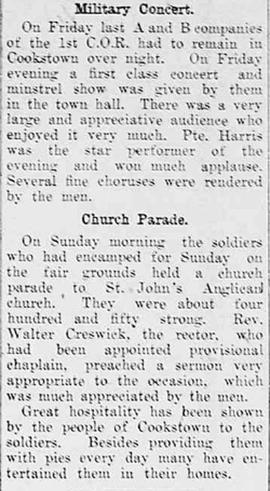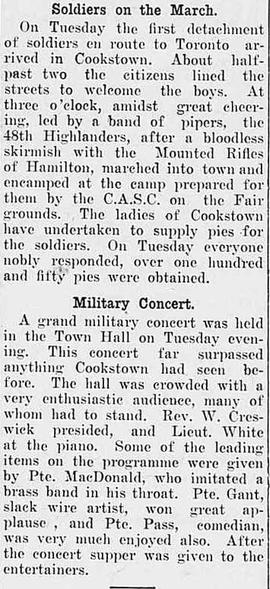- CA BWGPL LHC-Her-WWII-2016-08-31-05
- Item
- 1994-06-08
Part of Local History Collection
"It has been described as the largest invasionary force ever amassed.
On June 6th, 1944, ships "covered the sea" in the staging area between the Isle of Wight and Normandy, preparing to carry 150,000 American, Canadian and British troops to five key beachheads in France.
As the troops prepared for invasion, 11,000 planes began their bombing runs shortly after midnight, dropping nearly 1,800 tons of bombs on German positions. Paratroops, including the 1st Canadian Parachute Battalion, were dropped behind enemy lines, and 500 battleships moved into position to shell the Normandy coastline.
The Allied invasion of Europe, dubbed Operation Overlord, was originally scheduled for June 5th, but delayed by stormy weather. When meteorological reports suggested a break in the weather on the 6th, the invasion was ordered to go ahead - through seas so rough that most soldiers were seasick on the passage across the Channel.
The assault began at 6:30 a.a., on the beaches code-named Utah, Omaha, Gold, Juno and Sword. The 15,000 to 20,000 troops of the 3rd Canadian Division concentrated on Juno, and the villages of Vaux, Graye-sur-Mer, Courseulles-sur-Mer, Beiniere-sur-Mer, and St. Aubin-sur-Mer,
Shortly after 8 a.m., the Canadian forces hit the beaches. Some battalions met little resistance, finding that the way had been cleared by the earlier bombardment; others discovered that the enemy positions were still intact, and faced heavy fire.
Among the first to land were the Royal Canadian Engineers, called on to blast through the concrete seawalls and barbed wire that blocked the coast, clear minefields, and prepare roads for advancing forces; and the Royal Canadian Army Medical Corps. Many of the Medics were killed while trying to assist wounded soldiers in that first assault.
By the end of the first day of fighting, 4,000 allied troops had been killed, 342 of them Canadians. But the beacheheads had been established, and the Canadians had penetrated as far as 11 km inland.
It was the beginning of the end for the Nazi war machine. Eleven months later, on May 7th, 1945, Germany surrendered.
"War is nothing but death, disease, destruction, disablement...and a terrible waste." - D-Day veteran."
Bradford Witness


